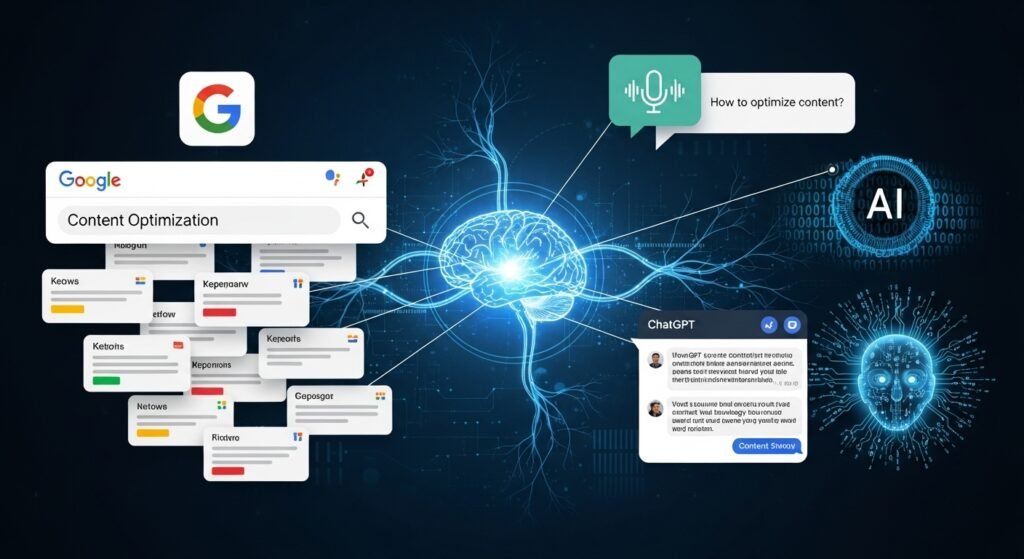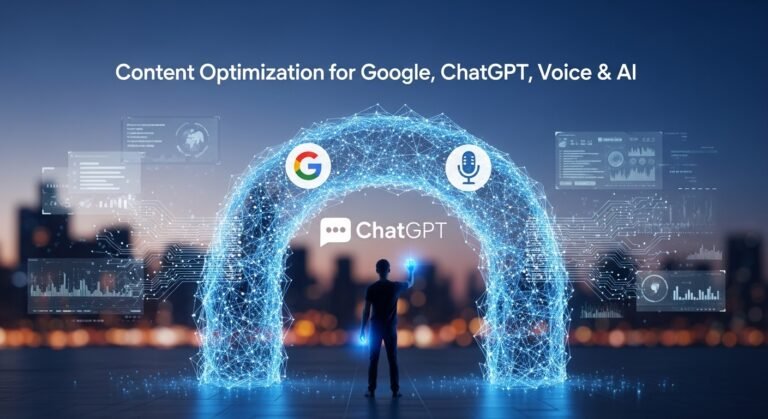Staying visible in today’s ever-changing digital world is more than just ranking on search engines. Users are searching through Google, asking ChatGPT, using Siri and Alexa, and interacting with AI-powered apps every single day. If you want your brand to be where your audience is, you need to optimize your content across all these touchpoints. This guide explores how you can make your content future-proof by aligning it with modern algorithms, leveraging SEO keyword research, and keeping pace with AI’s evolution.
Why Content Visibility Matters More Than Ever
Digital visibility isn’t just about getting clicks anymore. People want quick, clear answers whether they’re typing, speaking, or prompting an AI model. Search behavior has shifted from keyword-heavy queries to natural conversations. That means your content must be easy to discover by:
- Google’s search index
- ChatGPT and other AI assistants
- Voice search platforms like Alexa, Siri, and Google Assistant
- AI-driven recommendation engines
When you align your strategy with these platforms, you build a strong foundation for brand awareness, traffic, and credibility.
The Role of SEO Keyword Research in Modern Optimization
SEO keyword research remains the cornerstone of content strategy, even as technology evolves. It helps you understand the exact words and phrases your audience uses. But today, it’s not only about stuffing keywords; it’s about blending them naturally into engaging, helpful content.
A well-planned SEO keyword research process can help you:
- Identify search intent across text and voice queries
- Target conversational phrases for AI-driven results
- Spot gaps in competitor content
- Support structured data strategies that boost visibility
By weaving your target terms into high-quality articles, FAQs, and product pages, you create content that satisfies both users and algorithms.
How Google’s Algorithm Handles AI and Spam
Google’s latest spam update focuses on content authenticity, expertise, and originality. The algorithm rewards pages that demonstrate genuine insight while filtering out AI-generated spam or shallow articles.
This doesn’t mean you can’t use AI to assist with content creation. Instead, it means you must pair AI tools with human oversight. Use AI for brainstorming, drafting, or idea expansion, but ensure every piece is reviewed for accuracy, tone, and value.
AI Overview: Lessons from the Google Spam Update
AI-generated text is now everywhere, and Google knows it. The spam update targets low-quality automation that produces repetitive, unhelpful, or plagiarized material. To stay compliant:
- Maintain originality: even if you use AI, inject personal insights, research, or case studies.
- Prioritize helpfulness: address user needs, not just algorithms.
- Use structured data to help search engines understand your content.
High-quality content that blends human creativity with responsible AI use stands out in this environment.
Optimizing for ChatGPT and AI Assistants

Large language models like ChatGPT pull information from a mix of licensed data, publicly available sources, and their training knowledge. They prioritize clarity, factual accuracy, and relevance when presenting answers. To be part of these answers:
- Write comprehensive resources on your niche
- Structure content with clear headings and FAQs
- Keep sentences concise but informative
- Use conversational phrasing that mirrors how people speak
For example, if you’re a fitness coach, you might create an in-depth guide on home workouts that answers common questions like “How can I stay fit without a gym?” This makes it easy for AI to retrieve your expertise.
Voice Search: Optimizing for Spoken Queries
Voice search requires a different mindset from text search. People speak in full sentences, ask follow-up questions, and expect fast answers. To optimize for voice:
- Focus on long-tail keywords and question-based phrases
- Use natural language rather than jargon
- Provide concise answers at the top of your content
- Include a dedicated FAQ section
A smart SEO keyword research process can reveal the exact phrases users speak into their devices, helping you tailor your content accordingly.
Structured Data and Rich Snippets
Structured data gives search engines additional context about your pages. By marking up content with schema.org tags, you improve your chances of appearing in rich results, featured snippets, and even AI-powered search previews.
Consider adding structured data for:
- Articles and blogs
- FAQs and How-To guides
- Products and reviews
- Events and recipes
This makes your site more machine-readable, which benefits both Google and AI assistants scanning your pages.
Creating High-Value Content
Visibility depends on value. Even the best SEO keyword research won’t help if your content isn’t useful. Prioritize quality by:
- Addressing real-world problems your audience faces
- Sharing unique data, stories, or case studies
- Updating old articles to keep them fresh
- Mixing formats (articles, videos, infographics, podcasts)
When readers find your work engaging and helpful, they’re more likely to stay, share, and return.
Content Optimization Workflow
A streamlined process keeps your optimization efforts consistent. Here’s a suggested workflow:
- Research: Conduct in-depth SEO keyword research for text, voice, and AI queries.
- Plan: Map content ideas to buyer needs and search intent.
- Create: Produce detailed, original, and engaging content.
- Optimize: Add keywords naturally, structure headings, and insert relevant links.
- Publish: Launch with clean metadata, optimized images, and structured data.
- Promote: Share on social channels, newsletters, and communities.
- Review: Monitor rankings, AI mentions, and engagement; update as needed.
Measuring Success
Tracking performance is vital to know if your efforts are working. Focus on metrics like:
- Organic search traffic
- Voice search impressions (from Google Search Console)
- AI assistant mentions (via brand monitoring tools)
- Engagement rates on articles and videos
- Conversion goals like sign-ups or sales
Combine analytics with feedback from your audience to refine your approach.
Future-Proofing Your Strategy
The way people access information will continue to evolve. Emerging technologies like multimodal AI (text + image), augmented reality, and personalized voice assistants will change how content is discovered.
To stay ahead:
- Follow search engine updates and best practices
- Keep improving your SEO keyword research skills
- Experiment with new formats like interactive tools or AI-enhanced media
- Build authority in your field through thought leadership
Conclusion
Staying visible everywhere isn’t about chasing every new tool or algorithm. It’s about building a solid foundation with clear, user-focused content supported by strong SEO keyword research. Combine this with thoughtful optimization for Google, ChatGPT, voice search, and AI, and you’ll create an online presence that thrives even as the digital landscape shifts.
By focusing on authenticity, value, and adaptability, you position your brand as a trusted source of knowledge — ready to meet your audience wherever they search, speak, or ask.
Frequently Asked Questions (FAQs)
How does SEO keyword research help with AI visibility?
SEO keyword research identifies the words and phrases your audience uses, helping you craft content that AI models like ChatGPT can understand and surface in responses. It also supports structured data that improves machine readability.
Can AI-generated content rank on Google?
Yes, AI-generated content can rank if it meets Google’s standards for quality, originality, and usefulness. Human oversight is essential to ensure content aligns with expertise and adds genuine value.
What is the difference between voice search optimization and traditional SEO?
Voice search optimization focuses on natural, conversational language and question-based phrases, while traditional SEO often targets shorter, typed keywords. Voice search requires concise, spoken-friendly answers.
How often should I update my content for better visibility?
Review your content at least every six months. Update statistics, refresh examples, and align with any algorithm or AI changes. Evergreen content benefits from regular maintenance to stay relevant.
What role does structured data play in content optimization?
Structured data gives search engines and AI assistants a clearer understanding of your content, increasing your chances of appearing in rich results, featured snippets, and voice responses.
How do I make sure my content is compliant with Google’s spam updates?
Focus on originality, usefulness, and authenticity. Avoid over-automation, and always review AI-generated drafts to maintain accuracy and a human touch.
Is optimizing for ChatGPT different from optimizing for Google?
The principles are similar: focus on quality, clarity, and value. However, ChatGPT favors well-organized, conversational content with clear answers, while Google also considers backlinks, page speed, and other technical signals.



